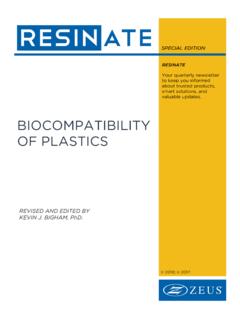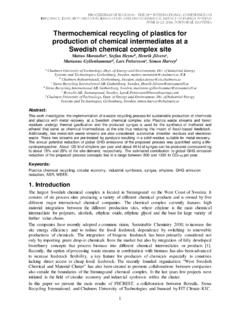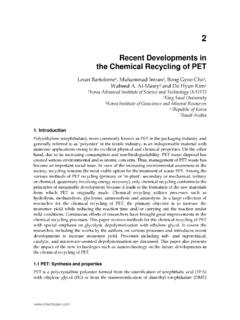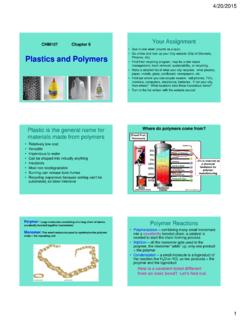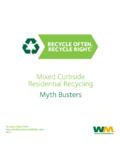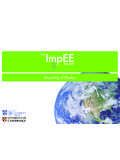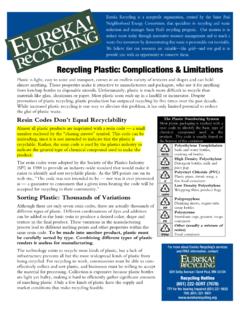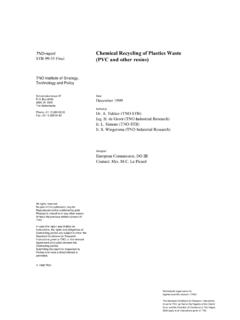Transcription of A Novel Method for Chemical Recycling of PLA Under Mild ...
1 A Novel Method for Chemical Recycling of PLA Under Mild Paper | Zeus Industrial Products, Anneaux, , John Campanelli, , Elizabeth Foley, Industrial Products, Orangeburg, SCMay 1, Paper | Zeus Industrial Products, Novel Method for Chemical Recycling of PLA Under Mild ConditionsA Novel Method for Recycling PLA using low-temperature, low-pressure reactions with alcohol or water has been discovered by Zeus Research. PLA is used today in many applications ranging from food packaging to implantable medical devices. Because of its sensitivity to thermal degradation, PLA is difficult to recycle and actually becomes a contaminant in the plastics stream of municipal solid waste. Using the newly discovered process, different grades of PLA can be removed from a stream of commingled plastics and broken down to give high value chemicals. Some of these chemicals, called monomers, can be purified and used as feedstock to synthesize virgin PLA resin, thereby closing the loop on the PLA life cycle.
2 The Method has low capital and operating costs and is well-suited to industrial Recycling processes. Moreover, it is consistent with the concepts of sustainability and of a circular ISSUES Low-temp/pressure Tin Catalyst Utilization Helps Circular Economy Monomers can be purified and used as feedstock to synthesize virgin PLA resin, thereby closing the loop on the PLA life Case Study | Zeus Industrial Products, Novel Method for Chemical Recycling of PLA Under Mild ConditionsZeus Industrial Products, Inc., is a manufacturer and processor of highly engineered polymers including bioabsorbable polylactide (PLA) and lactide copolymers catering to a variety of markets, including medical applications. Sustainability is a growing part of the Zeus culture and end-of-life issues are increasingly considered at the corporate level for all businesses. Recently, the Zeus Research team has developed a Novel technology for recovering monomers from recycled PLA, whether present as clean industrial waste or commingled with other plastics .
3 This depolymerization technology can be carried out efficiently at relatively mild conditions of temperature and pressure, and can be viewed generally as an effective enabling technology for dealing with PLA scrap economically. As a biopolymer from renewable resources, PLA is one of the fastest growing plastics in commercial use today especially in the field of packaging. There is a growing impetus to finding economical methods of dealing with its end-of-life issues in a manner consistent with the principles of a circular economy [1]. In this paper, the Zeus depolymerization process for PLA is described in detail along with potential applications to commingled plastic waste IN TODAY S ECONOMYP olylactic acid, PLA, is a plastic derived from plant starch (usually corn). In recent years, PLA has been growing in popularity as an alternative to petroleum-based plastics such as high density polyethylene, HDPE, low INTRODUCTIONP lastics retain a high added value throughout their life cycles.
4 Much of this value is lost if a plastic article is discarded at the end of its useful polyethylene, LDPE, polypropylene, PP, polystyrene, PS, nylon, PA, and polyethylene terephthalate, PET. This growth has been fueled in part by increased production efficiencies that have lowered costs, by improvements in polymer properties that have made PLA suitable for many packaging applications, and by consumer desire to utilize materials from renewable resources [2].Everything from clamshells for fast food to bioabsorbable medical devices can be made from PLA, drastically reducing the carbon footprint in these industries. The demand for PLA has grown as society embraces the importance of sustainability and of a circular economy. Global production capacity of PLA is expected to grow by 50% by the year 2022 to over 250,000 metric tonnes, with the bulk of the production going towards packaging applications [3].
5 Case Study | Zeus Industrial Products, Novel Method for Chemical Recycling of PLA Under Mild ConditionsRECYCLING OPTIONS FOR PLAThe expected growth of PLA in consumer applications over the next five years means an increased presence of the resin in post-consumer waste streams. Table 1 shows the alternatives available to recover the added value of PLA after its useful are important considerations to take into account before selecting an end-of-life strategy for PLA [4]. Although PLA does biodegrade, it does so very slowly in the environment. In a landfill, which is tightly packed and designed to exclude light and oxygen, the degradation process is even slower. Scientists estimate that a PLA bottle could take anywhere from 100 to 1,000 years to decompose in a landfill [5].PLA may eventually break down into its constituent parts (carbon dioxide and water) within three months in a controlled composting environment, that is, an industrial composting facility heated to 140 degrees Fahrenheit and fed a steady stream of digestive microbes.
6 PRECEDENTS cientists estimate that a PLA bottle could take between 100 to 1,000 years to decompose in a 1. End-of-Life Value Recovery Options for PlasticsEND-OF-LIFE OPTIONSRESOURCES RECOVEREDVALUEL andfillingnone-Compostingbiomass+Inciner ationthermal energy+Traditional Recyclingpolymer for reuse or re-forming++ Chemical Recyclingconstituent chemicals+++Unfortunately, there are only a few hundred industrial-grade composting facilities available across the United States. Incineration recovers the fuel value of the polymer, while traditional (or mechanical) Recycling reprocesses the material into an article with properties and value lower than the original article. PLA acts as a contaminant within a stream of mixed postconsumer waste plastics due to its propensity for thermal degradation during reprocessing compared to other constituents of the recycle stream (such as polyolefins, nylons and aromatic polyesters).
7 It must therefore be removed using costly methods prior to mechanical Chemical Recycling , the polymer is broken down into constituent monomers or oligomers (short chains of monomers) which can then be recovered, reprocessed and sold. Recovered monomers can be repolymerized directly into the original polymer, thereby closing the loop. Table 1 summarizes the end of life recovery options currently available for plastics . Case Study | Zeus Industrial Products, Novel Method for Chemical Recycling of PLA Under Mild ConditionsUsing recycled PLA frees up farmland to produce corn or other crops for human or livestock Recycling OF PLAR esources in terms of energy and capital equipment are required to implement Chemical Recycling processes. In many jurisdictions, government incentives will also be available. For Chemical Recycling of a polymer to be viable, resource costs should be comparable to or lower than the costs of manufacturing the monomers or oligomers from raw materials.
8 For each pound of PLA manufactured, pounds of corn are required [6]. Therefore, the impetus for obtaining monomer from a waste source is certainly present. A further benefit of utilizing recycled PLA as a source of monomer is freeing up of farmland to produce corn or other crops for human consumption or for are a number of processes available for Chemical Recycling of PLA by hydrolytic or alcoholytic depolymerization [7, 8, 9, 10]. However, these processes tend to be high-temperature, energy-intensive ones. Recently, processes utilizing temperatures as low as 80 C have been disclosed [11, 12, 13, 14], thereby improving the economics of Chemical Recycling . The Zeus process further enhances the economic viability of PLA depolymerization processes by using miscible systems of PLA/solvent/reactant to enable monomer recovery at even lower temperatures in an extremely efficient, environmentally-friendly ZEUS WASTE PLA DEPOLYMERIZATION PROCESSF igure 1 below shows one possible configura-tion of unit operations in a depolymerization process to deal with a stream of commingled plastic post-consumer waste that includes scrap PLA according to the Zeus process.
9 Figure 1 shows a schematic representation of a depolymerization Case Study | Zeus Industrial Products, Novel Method for Chemical Recycling of PLA Under Mild ConditionsAfter an initial washing step, the commingled plastic stream is subjected to size reduction using common methods such as shredders and grinders to make flake-size granules that can be readily separated. Separation of the various plastics can be done in a variety of ways including electrostatic separation, infrared techniques as well as flotation. This last Method is easily carried out to separate polyolefins (with specific gravity below 1) from nylons and polyesters. The crucial part of the process is separating biodegradable plastics like PLA from reprocessable plastics like PET. In a mixed stream of polyesters, this separation can be carried out by contacting the stream with a solvent like chloroform to dissolve the PLA component.
10 The undissolved PET can subsequently be dried and sent for further PLA solution is then subjected to alcoholysis, or reaction with an alcohol. High molecular weight PLA can be dissolved to about 15% by weight into chloroform. Alcohol is then added in stoichiometric excess to favor depolymerization. As long as the PLA remains dissolved, the scission reactions can occur without being limited by interphase transport of the reactant to the polymer. Temperature can be increased to just below the boiling point of the mixture s lowest boiling component to speed up the reaction without necessitating high pressure equipment. The addition of a tin catalyst has been found to greatly increase the reaction kinetics at these mild conditions of temperature. Since the depolymerization process occurs at low temperatures and atmospheric pressures, a variety of reactors can be used. Continuous stirred tank reactors or plug flow reactors are examples of the more common types.
